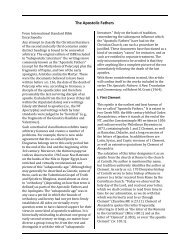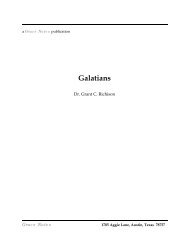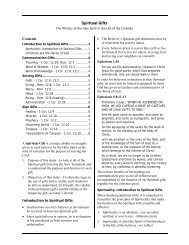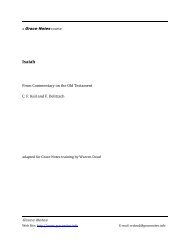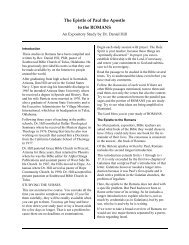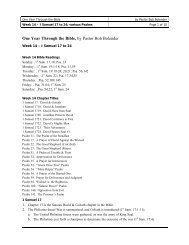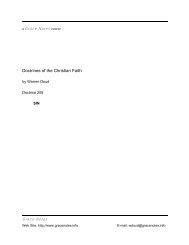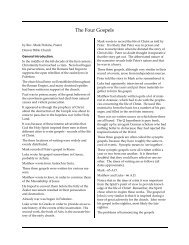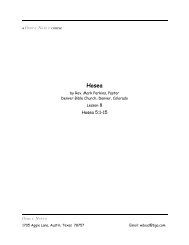Song of Solomon - Grace Notes
Song of Solomon - Grace Notes
Song of Solomon - Grace Notes
You also want an ePaper? Increase the reach of your titles
YUMPU automatically turns print PDFs into web optimized ePapers that Google loves.
SONG OF SOLOMON Page 34By C. F. Keil and F. Delitzscha <strong>Grace</strong> <strong>Notes</strong> studyThe description <strong>of</strong> spring is finished by areference to the fig-tree and the vine, thestanding attributes <strong>of</strong> a prosperous andpeaceful homestead, 1 Kings 5:5; 2 Kings 18:31.and thus named, not from their ,פָ נַ ג (from פַ גhardness, but their delicacy) are the little fruits<strong>of</strong> the fig-tree which now, when the harvestrainsare over, and the spring commences withthe equinox <strong>of</strong> Nisan, already begin to assume ared colour; the verb חָ נַט does not mean “togrow into a bulb,” as Böttch. imagines; it hasonly the two meanings, condire (condiri, postbibl.syn. <strong>of</strong> שֵ ל (בָ and rubescere. From its colour,wheat has the name נְׁטָ ה = חִ טָ ה ;חִ and here alsothe idea <strong>of</strong> colour has the preference, forbecoming fragrant does not occur in spring,—inthe history <strong>of</strong> the cursing <strong>of</strong> the fig-tree at thetime <strong>of</strong> the Passover, Mark (Mark 11:13) says,“for the time <strong>of</strong> figs was not yet.” In fig-trees, bythis time the green <strong>of</strong> the fruit-formation,סְׁ מָ דַ ר changes its colour, and the vines areblossom, i.e., are in a state <strong>of</strong> bloom (LXXυπ ίζ υσ ; cf. 7:13, υπ σ ς)—it is a clausesuch as Ex. 9:31, and to which “they diffusefragrance” (v. 13) is parallel. This word סמדר isusually regarded as a compound word,consisting <strong>of</strong> ם ,סַ scent, and דָ ר ,הָ brightness =blossom (vid., Gesen. Thes.); it is undeniablethat there are such compound formations, e.g.,(Arab.) from ,חַ לָ מִ יש ;שָ אַ ן and שָ לָ ה from ,שַ לְׁ אֲ נָ ןḥams, to be hard, and hals, to be dark-brown.But the traditional reading סְׁ מָ דַ ר (not מָ דָ ר (סְׁ isunfavourable to this view; the middle āaccordingly, as in לָ צַ ל ,צְׁ presents itself as an ante-tone vowel (Ewald, § 154a), and the stemwordappears as a quadril. which may be theexpansion <strong>of</strong> דֵ ר ,סִ to range, put in order in thesense <strong>of</strong> placing asunder, unfolding. Symm.renders the word by ἰ ά θη, and the Talm.idiom shows that not only the green five-leavedblossoms <strong>of</strong> the vine were so named, but alsothe fruit-buds and the first shoots <strong>of</strong> the grapes.Here, as the words “they diffuse fragrance” (asat 7:14 <strong>of</strong> the mandrakes) show, the vineblossomis meant which fills the vineyard withan incomparably delicate fragrance. At the close<strong>of</strong> the invitation to enjoy the spring, the call“Rise up,” etc., with which it began, is repeated.The Chethîb ,לכי if not an error in writing, justlyset aside by the Kerî, is to be read לֵ כִ י (cf. Syr.bechi, in thee, lvotechi, to thee, but with occulti)—a North Palestinism for ְך ,לָ like 2 Kings 4:2,where the Kerî has substituted the usual form(vid., under Ps. 103 introd.) for this verydialectic form, which is there undoubtedlyoriginal.<strong>Song</strong> 2:14. <strong>Solomon</strong> further relates how hedrew her to himself out <strong>of</strong> her retirement:My dove in the clefts <strong>of</strong> the rock,In the hiding-place <strong>of</strong> the cliff;Let me see thy countenance,Let me hear thy voice!For thy voice is sweet and thy countenancecomely.“Dove” (for which Castellio, columbula, likevulticulum, voculam) is a name <strong>of</strong> endearmentwhich Shulamith shares with the church <strong>of</strong> God,Ps. 74:19; cf. 56:1; Hos. 7:11. The wood-pigeonbuilds its nest in the clefts <strong>of</strong> the rocks andother steep rocky places, Jer. 48:28. ThatShulamith is thus here named, shows that, farremoved from intercourse with the world, her,חֶּ גֶּ ו from ,חַ גְׁ וֵ י mountains. home was among theor also גּו ,חָ requires a verb חָ גָ ה = (Arab.) khajja,findere. לַ ע ,סֶּ as a Himyar. lexicographer definesit, is a cleft into the mountains after the nature<strong>of</strong> a defile; with ,צּור only the ideas <strong>of</strong>inaccessibility and remoteness are connected;with ,סלע those <strong>of</strong> a secure hiding-place, and,מַ דְׁ רֵ גָ ה residence. indeed, a convenient, pleasantis the stairs; here the rocky stairs, as the twochalk-cliffs on the Rügen, which sinkperpendicularly to the sea, are called“Stubbenkammer,” a corruption <strong>of</strong> the SlavonicStupnhkamen, i.e., the Stair-Rock. “Let me see,”said he, as he called upon her with enticingwords, “thy countenance;” and adds this as areason, “for thy countenance is lovely.” The



